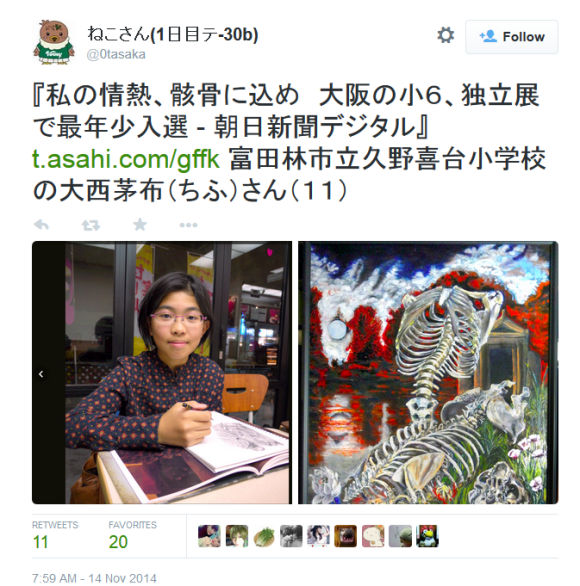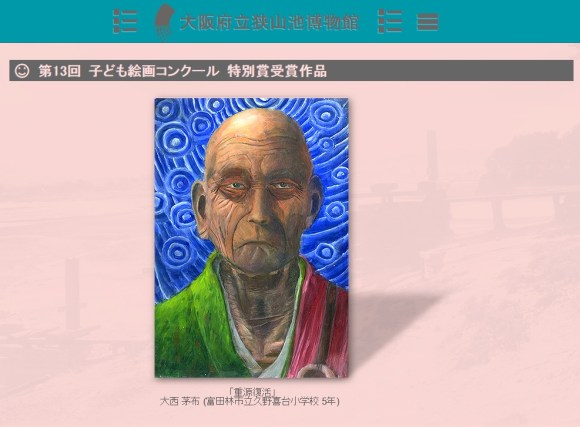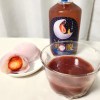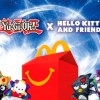
One of the words for art in Japanese is bijutsu which contains the kanji character for “beauty” (美). That’s not to say that art is limited to images of beauty alone, however. Sometimes images considered superficially unpleasant can be seen as beautiful works as well. They have the power to push back the darkness of taboos and help us to overcome our own inhibiting fears and prejudices.
Those are pretty heavy concepts for sixth-grader Chifu Onishi, but she seems to have already excelled at them through her celebrated artwork such as Tsuki Ni Asobu (Play on the Moon) which was chosen as a part of the 82nd annual Dokuritsu Exhibition, an annual event that has featured some of Japan’s greatest artists in the past. This acknowledgement also earns the 11-year-old the recognition of being the youngest artist to ever take part.
■ Play on the Moon
The Dokuritsu Exhibition has been ongoing since before World War II and is unique in its judgment of art regardless of fame, age, or background. Established artists compete on exactly the same footing as schoolchildren such as Onishi. In this year’s exhibit only 700 of the 1,989 works were chosen.
Tsuki Ni Asobu probably isn’t what you’d expect an 11-year-old girl to produce, featuring a pair of dismembered skeletons piled in a marsh in front of a blood-red sky.
▼ “This picture makes me worry about the child’s mental state…”
私の情熱、骸骨に込め 大阪の小6、独立展で最年少入選 - 朝日新聞デジタル http://t.co/n02aGRtZr6
— 黒々 (@kuro_indar) November 14, 2014
この子の精神状態が心配になる絵だ… pic.twitter.com/K1tTaJ5yuO
On the other hand, there is nothing outright gruesome about the picture. At the bottom beautiful flowers can be seen jutting up from vividly blue water. When focusing less on the skeletons the red backdrop appears to take the form of autumn leaves.
Onishi is tight-lipped on what the painting is meant to symbolize. She would like to let each viewer interpret Tsuki Ni Asobu in their own way. She did say, however, that she is attracted to scary things because they are more honest, and that smiling faces tend to lie more.
▼ Onishi’s Jugen Fukkatsu also won a prize at the Osaka Prefectural Sayamaike Museum’s 13th Children’s Art Contest
■ Part of the Family
Chifu Onishi lives in Tondabayashi, Osaka with her father, Hirofumi, who divorced from Chifu’s mother when she was five. During first and second grade sports festivals, she came in dead last during footraces. Determined to boost her self-confidence, Hirofumi took his daughter running in park in preparation for the third grade race. However, when the following year came, she again finished in last place.
Dismayed Hirofumi confronted his daughter asking her if she could be content being in last place for the rest of her life or if there was anything she could be good at. She answered determinedly that she was good at drawing, a hobby she picked up while sketching stag beetles from a popular video game Mushi King.
“Fine then. Draw every day,” he told her, and she did. Each day she would work with either a pencil or brush in her hand for no less than three hours. She started by trying to reproduce paintings found in art books lying around the house. Then her art teacher recommended practicing drawing people by first learning to draw bones.
Following her teacher’s advice Chifu drew human bones from anatomy books, until one day her father came home with a surprise: a full-sized human skeleton like you might find in a biology classroom. She described the skeleton as unsettling at first but the more time they spent with it, the more it became like a part of the family.
“I especially liked looking at the face. I would stare at it and wonder what they looked like when they were alive.”
(Chifu Onishi)
A skeleton is merely an image of inanimate human bones which only has the power that we ascribe to it. By rejecting such imagery with outright revulsion we might deprive ourselves of something beautiful beneath its surface. In the same way, perhaps by facing our shortcomings head-on without fear or anger we can find success within the failures of our lives.
*Tsuki Ni Asobu will be on display at the Kyoto Municipal Museum of Art from 27 November to 7 December
Source: Asahi Shimbun, Hachima Kiko, Sayamaike Museum (Japanese)
『私の情熱、骸骨に込め 大阪の小6、独立展で最年少入選 - 朝日新聞デジタル』 http://t.co/vcjlk783mZ 富田林市立久野喜台小学校の大西茅布(ちふ)さん(11) pic.twitter.com/84faJD1H8v
— ねこさん(とり) (@0tasaka) November 14, 2014


 Converse All-Stars team up with two all-stars of Japanese art for Wave, Skull ukiyo-e shoes【Pics】
Converse All-Stars team up with two all-stars of Japanese art for Wave, Skull ukiyo-e shoes【Pics】 Famous Japanese painter’s centuries-old cat artwork proves Japan has always loved felines
Famous Japanese painter’s centuries-old cat artwork proves Japan has always loved felines We visit Kaiyodo Kappa Museum: dedicated to a yokai that loves cucumbers and human souls
We visit Kaiyodo Kappa Museum: dedicated to a yokai that loves cucumbers and human souls Foreign tourists pick the top 10 must-visit museums in Japan
Foreign tourists pick the top 10 must-visit museums in Japan Tokyo museum’s current exhibition offers a dose of retro style and romance from 100 years ago
Tokyo museum’s current exhibition offers a dose of retro style and romance from 100 years ago Beautiful new Final Fantasy T-shirt collection on the way from Uniqlo【Photos】
Beautiful new Final Fantasy T-shirt collection on the way from Uniqlo【Photos】 Randomly running into a great sushi lunch like this is one of the best things about eating in Tokyo
Randomly running into a great sushi lunch like this is one of the best things about eating in Tokyo Disney princesses get official manga makeovers for Manga Princess Cafe opening in Tokyo
Disney princesses get official manga makeovers for Manga Princess Cafe opening in Tokyo Foreign English teachers in Japan pick their favorite Japanese-language phrases【Survey】
Foreign English teachers in Japan pick their favorite Japanese-language phrases【Survey】 Our reporter takes her 71-year-old mother to a visual kei concert for the first time
Our reporter takes her 71-year-old mother to a visual kei concert for the first time Is the new Shinkansen Train Desk ticket worth it?
Is the new Shinkansen Train Desk ticket worth it? Hey, Japanese taxi driver! Take us to your favorite restaurant in Tsuruga City!
Hey, Japanese taxi driver! Take us to your favorite restaurant in Tsuruga City! 11 different ways to say “father” in Japanese
11 different ways to say “father” in Japanese We tried Japan’s Strawberry Daifuku? liqueur, one of three dessert-themed liqueurs
We tried Japan’s Strawberry Daifuku? liqueur, one of three dessert-themed liqueurs Hello Kitty/Yu-Gi-Oh crossover Happy Meal toys appear, but far, far away from Japan
Hello Kitty/Yu-Gi-Oh crossover Happy Meal toys appear, but far, far away from Japan We try out “Chan Ramen”, an underground type of ramen popular in the ramen community
We try out “Chan Ramen”, an underground type of ramen popular in the ramen community New Studio Ghibli bedding sets are cool in all senses of the word
New Studio Ghibli bedding sets are cool in all senses of the word Our Japanese reporter visits Costco in the U.S., finds super American and very Japanese things
Our Japanese reporter visits Costco in the U.S., finds super American and very Japanese things New Pokémon cakes let you eat your way through Pikachu and all the Eevee evolutions
New Pokémon cakes let you eat your way through Pikachu and all the Eevee evolutions There’s a park inside Japan where you can also see Japan inside the park
There’s a park inside Japan where you can also see Japan inside the park Japanese convenience store packs a whole bento into an onigiri rice ball
Japanese convenience store packs a whole bento into an onigiri rice ball Hanton rice — a delicious regional food even most Japanese people don’t know about, but more should
Hanton rice — a delicious regional food even most Japanese people don’t know about, but more should Final Fantasy, Kingdom Hearts, and Dragon Quest pet product line announced by Square Enix
Final Fantasy, Kingdom Hearts, and Dragon Quest pet product line announced by Square Enix Studio Ghibli releases Kiki’s Delivery Service chocolate cake pouches in Japan
Studio Ghibli releases Kiki’s Delivery Service chocolate cake pouches in Japan Japan’s bone-breaking and record-breaking roller coaster is permanently shutting down
Japan’s bone-breaking and record-breaking roller coaster is permanently shutting down New definition of “Japanese whiskey” goes into effect to prevent fakes from fooling overseas buyers
New definition of “Japanese whiskey” goes into effect to prevent fakes from fooling overseas buyers Foreign passenger shoves conductor on one of the last full runs for Japan’s Thunderbird train
Foreign passenger shoves conductor on one of the last full runs for Japan’s Thunderbird train Kyoto bans tourists from geisha alleys in Gion, with fines for those who don’t follow rules
Kyoto bans tourists from geisha alleys in Gion, with fines for those who don’t follow rules Studio Ghibli unveils Mother’s Day gift set that captures the love in My Neighbour Totoro
Studio Ghibli unveils Mother’s Day gift set that captures the love in My Neighbour Totoro Domino’s Japan now sells…pizza ears?
Domino’s Japan now sells…pizza ears? Toyota built a life-sized Miraidon Pokémon and are letting people test drive it this weekend
Toyota built a life-sized Miraidon Pokémon and are letting people test drive it this weekend New Japanese KitKat flavour stars Sanrio characters, including Hello Kitty
New Japanese KitKat flavour stars Sanrio characters, including Hello Kitty Sales of Japan’s most convenient train ticket/shopping payment cards suspended indefinitely
Sales of Japan’s most convenient train ticket/shopping payment cards suspended indefinitely Sold-out Studio Ghibli desktop humidifiers are back so Totoro can help you through the dry season
Sold-out Studio Ghibli desktop humidifiers are back so Totoro can help you through the dry season Japanese government to make first change to romanization spelling rules since the 1950s
Japanese government to make first change to romanization spelling rules since the 1950s Ghibli founders Toshio Suzuki and Hayao Miyazaki contribute to Japanese whisky Totoro label design
Ghibli founders Toshio Suzuki and Hayao Miyazaki contribute to Japanese whisky Totoro label design Doraemon found buried at sea as scene from 1993 anime becomes real life【Photos】
Doraemon found buried at sea as scene from 1993 anime becomes real life【Photos】 Tokyo’s most famous Starbucks is closed
Tokyo’s most famous Starbucks is closed One Piece characters’ nationalities revealed, but fans have mixed opinions
One Piece characters’ nationalities revealed, but fans have mixed opinions We asked a Uniqlo employee what four things we should buy and their suggestions didn’t disappoint
We asked a Uniqlo employee what four things we should buy and their suggestions didn’t disappoint Princesses, fruits, and blacksmiths: Study reveals the 30 most unusual family names in Japan
Princesses, fruits, and blacksmiths: Study reveals the 30 most unusual family names in Japan Studio Ghibli’s new desktop Howl’s Moving Castle will take your stationery on an adventure
Studio Ghibli’s new desktop Howl’s Moving Castle will take your stationery on an adventure Filipino youths with special needs find their place in the world through art and awareness
Filipino youths with special needs find their place in the world through art and awareness These Edo-period sketches of human skeletons are oddly adorable despite being totally creepy
These Edo-period sketches of human skeletons are oddly adorable despite being totally creepy Immersive Museum offers impressive impressionist fun this summer in Tokyo
Immersive Museum offers impressive impressionist fun this summer in Tokyo “A dead bug” and other amusing, adorable, snarky, and downright ridiculous test responses
“A dead bug” and other amusing, adorable, snarky, and downright ridiculous test responses “Art” or “just lazy?” Tokyo art exhibition poster debated
“Art” or “just lazy?” Tokyo art exhibition poster debated Renowned Japanese calligraphy teacher ranks the top 10 kanji that foreigners like
Renowned Japanese calligraphy teacher ranks the top 10 kanji that foreigners like Press start, receive art: Japanese art gallery showcases bugged Nintendo screen canvases
Press start, receive art: Japanese art gallery showcases bugged Nintendo screen canvases Instagram queen Naomi Watanabe poses for avant-garde photoshoot, slays fans
Instagram queen Naomi Watanabe poses for avant-garde photoshoot, slays fans The new Simose Art Museum in Hiroshima houses a floating, futuristic surprise next to the sea
The new Simose Art Museum in Hiroshima houses a floating, futuristic surprise next to the sea Japanese netizens get into a debate over Britney Spears’ kids’ anime art
Japanese netizens get into a debate over Britney Spears’ kids’ anime art 2021 Magademy Award nominees announced, celebrating excellence in being a manga character
2021 Magademy Award nominees announced, celebrating excellence in being a manga character 13-year-old Japanese girl becomes first-ever women’s skateboarding Olympic gold medalist【Video】
13-year-old Japanese girl becomes first-ever women’s skateboarding Olympic gold medalist【Video】 Hello Kitty would look cute even if you peeled away all her flesh, new toy line shows us【Photos】
Hello Kitty would look cute even if you peeled away all her flesh, new toy line shows us【Photos】 Finally! First-ever Pokémon manhole covers installed in downtown Tokyo
Finally! First-ever Pokémon manhole covers installed in downtown Tokyo Amazing graduation project card game made by Kyoto University art student is simply incredible
Amazing graduation project card game made by Kyoto University art student is simply incredible
Leave a Reply